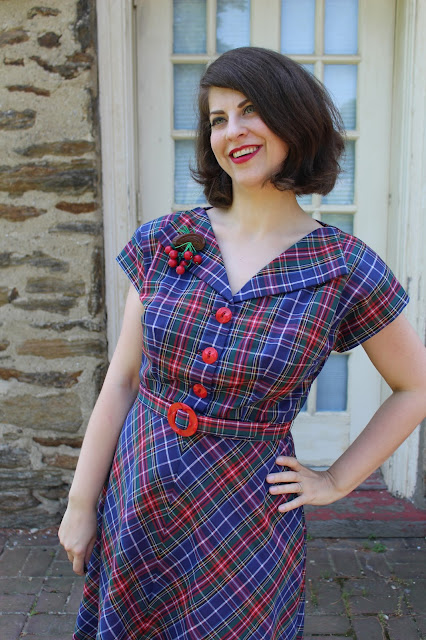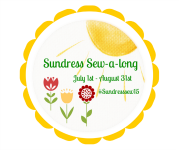Say you haven't sewn with plaid in years. You are well aware that your plaid matching skills are rather rusty and things could get a little dicey. Because of this you're entirely sensible and choose a simple pattern. Maybe a pull over top with a side seam zipper so you only have to plaid match across the shoulders and at the side seams. You get a little plaid matching refresher without tearing your hair out. Pleased with yourself you celebrate with cake.
Or you could think, "My plaid matching skills are a little rusty. Maybe I should sew a shirt dress with a big collar and a bias cut skirt. Don't have to plaid match across the waist seam. WINNING!" Fixated with this fact you fail to think about all those seams that do need to be plaid matched, some of them on the bias. Oh no, this project is going to be a "Piece Of Cake", you think while eating cake.
Now that you've seen a picture, it's pretty clear the direction I went in. Sensibility is not my strong point and I did think a bias cut skirt would be a piece of cake. I told myself that this worry over plaid matching was silly and everything would be fine. FINE. Thusly prepared with fake confidence I went forward to cut plaid fabric.
The plaid cutting technique I used was drawing a line on the pattern and lining it up with one of the white plaid lines. When pattern pieces were labeled cut two, the first piece was placed on top of the fabric to assist matching the second. This was most likely a fine cutting technique if I'd been a bit more careful. But I got a little sloppy and though, "That's close enough and I'll be about to make it work."
I also flat out made a cutting mistake. When cutting the second front, I plaid matched the white plaid lines but not the red ones. But that was an error that wasn't caught until much, much later. Well get to that in detail in a bit.
My order of assembly was to sew up the bodice first. All the darts, facings, shoulders and one side seam were stitched. I even went so far as to hand sewed the sleeve facings in place. All that went smoothly other than realizing that I hadn't plaid matched across the shoulders. Oh well, no use losing sleep over that detail now that the fabric was all cut.

After completing all those details the only thing left was sewing the bound buttonholes. I wasn't in the mood to tackle those yet. Sewing bound button holes is one of those things that always provokes a mild panic attack. Matching plaid on the bias skirt seams would be much easier...right? The first seam, CF, took one whole hour to sew. "Oh Crap! What have I gotten myself into and why are some of the plaid lines matching and some aren't?" After much trial and error it was discovered that the plaid intersections were just as important to getting good chevrons as just getting the colors to line up. Did I mention that my plaid matching skills were pretty rusty?

On the CF seam my cutting was almost correct. With just a little fudging of the 5/8" seam allowance I was able to get good alignment of the plaid. The rest of the seams wouldn't be so fortunate. The other 3 skirt seams had to be sewn at crazy seam allowances to get the correct match. One side would be 1/4" and the other would be at 3/4". I went back and trimmed down the larger side down to 1/4" so that the finished seam looked a little better. If any future seamstress looks at this dress they will probably wonder what the hell was going on. Maybe I shouldn't get so uppity about some of my vintage hand sewn dresses.
But back to our plaid matching saga, it is far from over. At this point I'd done a pretty good job during cutting keeping the repeats matched horizontally. Three skirt panels were sewn together with only a 1/4 or so of mismatch at the hem. It wasn't until panel number 4 that there was a big problem. I found that it needed to be shifted upwards an inch to get the side seams to match correctly. Eeeeep! A small thank you was said to vintage pattern drafters for using super deep hem allowances as I shortened the other 3 panels to match.
With the skirt finished it was time to finally tackle those bound buttonholes. I did refresh my brain on sewing those by rewatching the Sew Retro Starlet Jacket class on Craftsy. At least part of me learned something about doing proper prep work on this project. The bound buttonholes were a slow go, with plenty of ripping out. At least there weren't any horrible cutting mistakes and the finished holes looked pretty good. I moved on to the facing windows and then hand stitched the two layers together. Feeling pretty pleased with all my hard work, I went to baste the bodice pieces together and saw this.

NOOOOOOOOOOO!!! A thousand scream emojis have just been born. I thought, "OK, let's not freak out. The non buttonhole side can be replaced. Wait, which side matches the back?" You guessed it, the non buttonhole side. At this point I started manically laughing in the way crazy people do before they flip out and start stabbing everyone. I...Have....To...Redo....All....The...Buttonholes. Perhaps I should just fall on my sewing shears instead.
At that point my husband arrived home and said, "Time to go to the church picnic." This turned out to be a good thing because I couldn't lounge dramatically on picnic benches crying about mismatched plaid in front of near strangers. "No, no, you don't understand! They were bound buttonholes, bound! I have to dissemble half my work!" *Cue manic sobbing.* By the time we returned home I'd calmed down a bit and was able to deal all the work that had to be redone. There was some fabric left and I was able to cut a new front and facing that did match the other side. Praise the sewing goddess! She also made sure that second set of bound buttonholes sewed up a lot faster. Or it could have been all that practice bound buttonhole practice I'd just had. Bodice fixed, it was attached to the skirt which magically still fit. Thanks bias cut! The final bit of magic was that the skirt stretched before hemming and was no longer an inch shorter than I'd intended.
Pattern
McCall's 7977. Haven't seen this one floating around before purchasing my copy. This project counts as #vintagepledge number 5.
Fabrics used
Cotton shirting (May have a bit of poly in it. It was from my grandmother's stash and I didn't feel like doing a burn test.)
Pattern changes/alterations
- Added 1/2" through the waist and hips. For the hips I actually added the 1/2" throughout the length of the skirt.
- Shortened the bodice 3/8"
- Shortened the skirt 5.5" (Think as drafted this would have been a maxi skirt on me.)
One alteration I would go back and do is to take in the shoulders about 1/2 -3/4" Even with shoulder pads sewn in that area is a little big. You can see that the CF is collapsing a bit and it's from the excess in the shoulders. The actual bodice length is correct. (It took me completing the whole dress to finally figure out this issue.)
Confessions/Advice
- Make sure your plaid matches across center front before putting in bound buttonholes. Duh.
- This shirting was a bit more sheer than I'd anticipated before sewing it up. I've worn a red slip underneath the dress for the photos.
- I slapped some ready made shoulder pads in this dress at the last minute. I should go back and either use the shoulder pad pattern pieces provided or cover the ready made ones in self fabric.
- The belt and buttons were a vintage deadstock set I stumbled across on Etsy.
- Covered belt enthuses rejoice, I ran across an internet source for belt backing!
Sew-Biz Fabrics has a lots of widths available. Their website might be a little dated looking, but they shipped promptly and I was pleased with the backing in real life.
Husband Comment
"Hey look, you got all the lines to match. Oooo, they go up or down depending on how you look at them. I also like your belt buckle. But you didn't make that, just strapped it on there."
My Final Thoughts
With all the cutting snafus this project should have ended up in the trash can as an unfixable wadder. Maybe Grandma had my back on this one making sure it worked out in the end. I can tell you that she would have given me an earful about that bodice cutting error. She didn't hand out sympathy for being a dumbass and not paying attention. ;) She still would have made me 3 different things for lunch because she rocked.

So I've talked about plaid matching at length, but not about the actual pattern. Please forgive me lovely pattern, I'm still a bit shell shocked from making you. In a solid or non directional print this dress would be a snap to sew up. It has several design details that look as nice on a real body as they do in the fashion illustration. That's always nice since fashion illustrations don't have to worry about gravity or real life bust/waist/hip ratios. In recap, great pattern, fraught construction, awesome final dress. Now excuse me I have to stare at my skirt seams while eating cake. Ooooo plaid.































